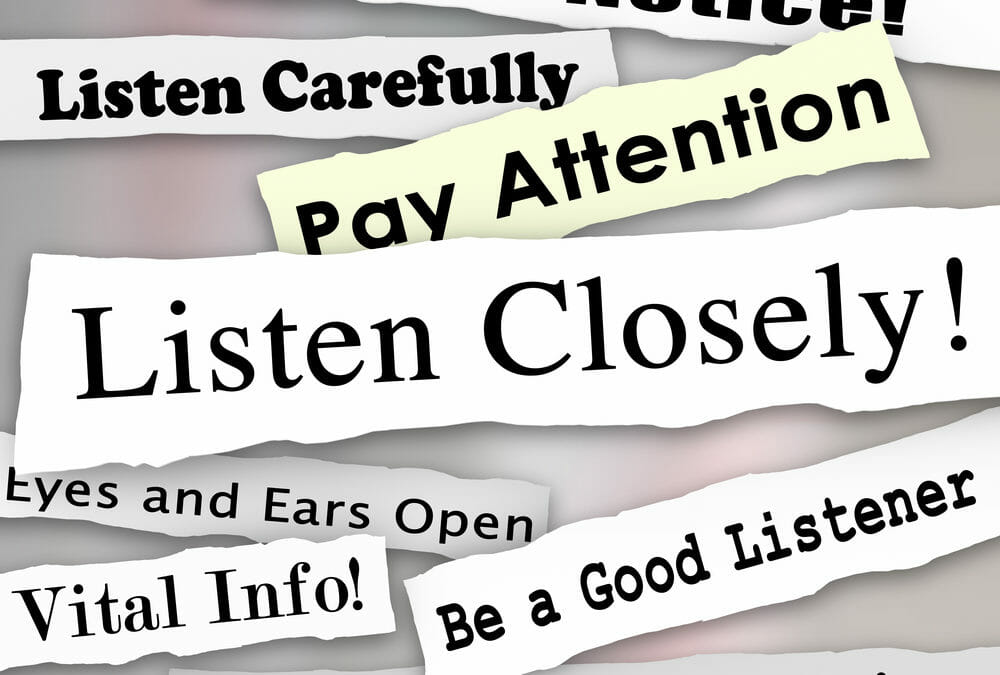
The Hidden Key to Communication
A lot has been written about effective communication: active listening, recognizing non verbal communication, asking questions, clarifying and summarizing your speaking points, providing feedback and developing trust and rapport. All of these tips make sense and are useful in any conversation. So with everything we’ve been taught to do or say, why is it that so many of us still feel we aren’t being heard? The real game changer, prior to all the techniques and strategies, is bringing ourselves fully to the conversation. The question then becomes: how do we do that?
Most of the time we just assume the person we’re talking to will hear what we’re saying, but how often does that really happen? It’s far more common to have a conversation with someone who’s simply waiting for us to finish so they can either give their opinion, defend their position, offer advice or refuse to be of any help whatsoever. And that’s not what we’re looking for.
Few people experience really being listened to. When the person we’re talking to is simply inhabiting their physical body we get a particular feeling about that. The most obvious indicator is that they’re not stopping what they’re doing to look you in the eye for more than a second because they’re distracted or checking their phone or multi-tasking. Beyond that, you sense the flatness; there’s no sense of connection and your words seem to bounce off a brick wall. Granted, not every conversation is one in which there’s deep connection and understanding. In a business context that’s often not possible and depending on the situation, maybe not even desirable. But what is possible is a simple acknowledgement of our shared humanness and an intention to have a positive exchange.
What if, in order to improve our experience – both for the listener and the speaker – we began by taking into account our state of mind? It’s certainly not the place most people start. It may seem overly simplistic to say that any conversation is significantly improved when we aren’t already preoccupied with a thousand different things, regardless of who’s doing the talking and who’s doing the listening. First you need to be aware when your mind is full of busy thoughts about problems you need to solve or people you need to deal with. That awareness by itself will break the spell of preoccupation and remind you to take a stop and really be with the person you’re talking to. It’s as easy as making sure your shoelaces are tied before you step out your door. Usually we get so caught up in the need to keep running that we don’t even think to look down until we trip up. But once we know the consequences of trying to run with untied shoelaces, we know to prepare in advance. It’s the same with having a conversation, only we look within ourselves rather than at something outside ourselves.
Our state of mind is colored by our mood and the feelings that go with it. We can improve our ability to relate to each other by factoring in the effect of our moods – both ours and the person we’re talking to. This is something that’s so fundamental we almost forget about it entirely. But, in fact, our low moods do affect our ability to communicate effectively. We forget that when we’re in a low mood, our ability to speak clearly or listen fully is minimized. When we’re feeling badly, it’s way too easy to fall into blame or resentment or defensiveness because we’re already feeling vulnerable, as if we somehow need to protect ourselves before anyone even has a chance to get the words out of their mouth.
If we give each other the breathing room to allow our moods to change, we have a far greater chance of engaging in conversation that may that may potentially contain an emotional charge. We start with noticing our own moods and how they make us feel, and then we begin to recognize how other people are also driven by their moods. This is a form of compassion that begins with you, a form of self care, if you will. And once you take care of yourself this way, you find you automatically extend the same kindness to others.
These dynamics – state of mind and mood – are equally true whether the conversation takes place in the office or the living room. For example, perhaps you run a business and have employees working for you, or you’re in a management position and want to be effective in engaging others in your vision. Understanding the nuances of the human condition is invaluable because it both increases your ability to convey what’s important to you and increases the engagement of those you work with.
As you increase your ability to recognize low moods and busy states of mind, you also become aware of the feelings connected to them. Self awareness is the gateway to so many improvements in our lives! We come to see not only what’s in our way but we gain access to our own resources we hadn’t noticed before. You come to see that low moods will pass and busy minds will settle without the need to manipulate them. They’re much like the clouds that cover over the sun; they dissipate on their own without our having to do anything to fix or improve them. Once we understand how transient moods and thoughts and feelings really are, we can either adjust our timing or make sure we create a safe and supportive context for dialogue.
Recognizing the role of our state of mind enables us to become fully present – and presence is transformative. It’s the real source of connection between us, and we all know when it’s there or it’s missing. When we can let go of rehearsing, anticipating or assuming anything about what might occur, we can set the stage for the most valuable and affirming possibilities to occur.
Nina Lockwood
Certified Transformative Coach

Nina Lockwood is a transformative coach, speaker, facilitator and trainer with over 30 years of expertise in psychology and personal development and 20 years in the fields of health and wellness. Drawing from an interdisciplinary background, Nina works with individuals and organizations to achieve improved performance, problem solving, productivity and to minimize the effects of stress and pressure.
For more information about Nina Lockwood go to
http://ninalockwood.com
Opinions expressed by Savvy Women blog contributors are their own.
